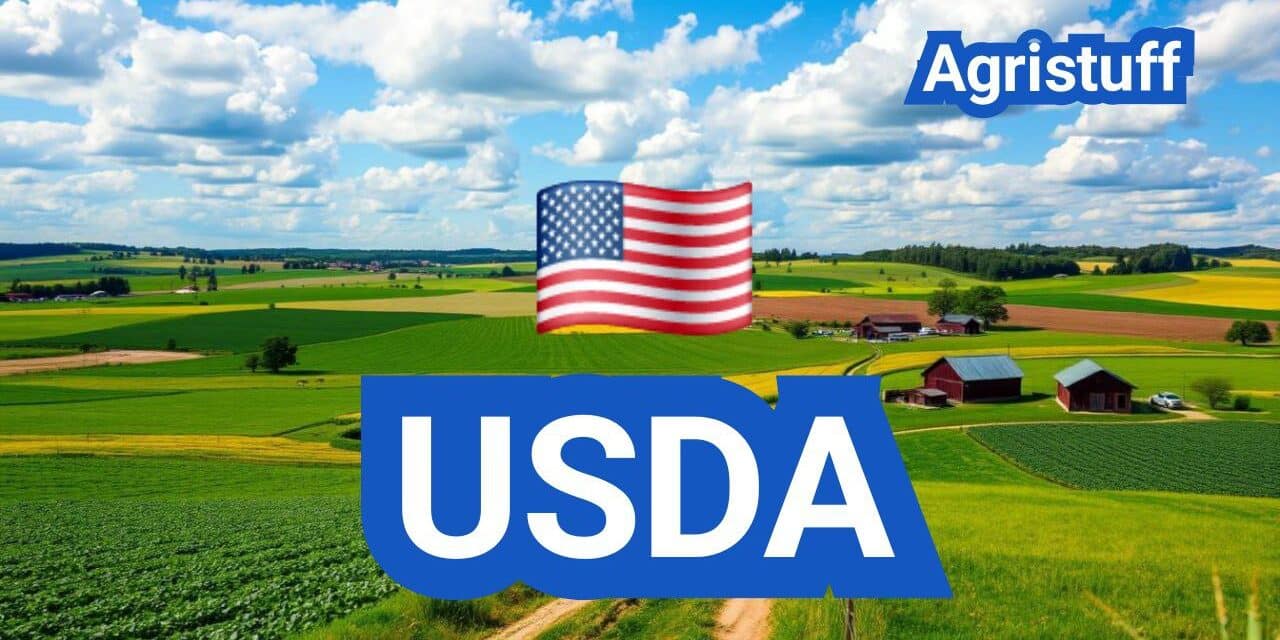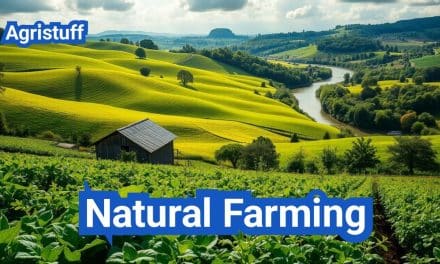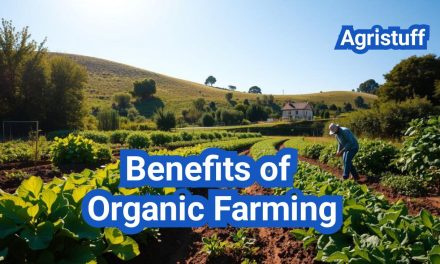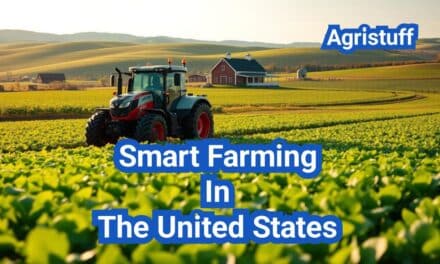The USDA is a vital part of the US federal government, overseeing the nation’s agricultural sector. Established to promote and protect American agriculture, the USDA plays a crucial role in ensuring food safety, conserving natural resources, and supporting rural communities.
The USDA’s mission encompasses a wide range of activities, from ensuring the safety of the nation’s food supply to providing financial assistance to farmers and ranchers. Through its various agencies and programs, the USDA works to achieve its goals, supporting the well-being of both rural and urban America.
Key Takeaways
- The USDA is a key federal agency responsible for the nation’s agricultural sector.
- It oversees food safety, conservation, and support for rural communities.
- The USDA provides financial assistance to farmers and ranchers.
- Its mission includes ensuring the safety of the nation’s food supply.
- The USDA supports the well-being of both rural and urban America through its programs.
Overview of the United States Department of Agriculture
The USDA was founded on May 15, 1862, by President Abraham Lincoln, marking the beginning of a new era in agricultural development. Since then, the department has grown significantly, now boasting a budget of $213 billion in 2024 and employing 105,778 people.
Founding and Historical Development
The USDA’s history is marked by its commitment to promoting agriculture and supporting rural communities. Over the years, it has evolved to address the changing needs of the agricultural sector, from ensuring food safety to implementing conservation programs. The department’s historical development has been shaped by various factors, including legislative changes and advancements in agricultural practices.
Current Mission and Strategic Goals
Today, the USDA’s mission is to promote agriculture, ensure food safety, and support rural development. Its strategic goals include:
- Supporting agricultural producers through programs and services
- Ensuring the safety of the nation’s food supply
- Promoting conservation and sustainable use of natural resources
- Fostering rural development and improving the quality of life for rural communities
The USDA achieves these goals through various initiatives, including the Food and Nutrition Service and the Forest Service, which play critical roles in addressing food security and promoting sustainable forestry practices.
USDA Organizational Structure and Leadership
The USDA’s leadership and organizational structure are designed to achieve its mission of promoting agriculture, natural resources, and rural development. The department is headed by the Secretary of Agriculture, a member of the President’s Cabinet.
Office of the Secretary and Administration
The Office of the Secretary is responsible for overseeing the overall direction and administration of the USDA. This includes setting policy, managing the department’s budget, and coordinating with other federal agencies.
Major Agencies and Their Functions
The USDA comprises several major agencies, each with distinct functions. For instance, the Farm Service Agency (FSA) provides financial assistance to farmers, while the Rural Business-Cooperative Service (RBCS) supports rural development initiatives. Other key agencies include the Forest Service, which manages national forests, and the Food Safety and Inspection Service, which ensures the safety of the nation’s meat, poultry, and egg products.
| Agency | Function |
|---|---|
| Farm Service Agency (FSA) | Provides financial assistance to farmers |
| Rural Business-Cooperative Service (RBCS) | Supports rural development initiatives |
| Forest Service | Manages national forests |
| Food Safety and Inspection Service | Ensures the safety of meat, poultry, and egg products |
State and Local Offices
The USDA’s presence extends to state and local levels through its various offices. These offices provide critical services and support to farmers, ranchers, and rural communities, ensuring that USDA programs are accessible to those who need them.
How to Access USDA Services and Resources
The USDA provides numerous online tools and resources to help agricultural producers and rural residents achieve their goals. These resources are designed to be accessible and user-friendly, making it easier for individuals and businesses to find the support they need.
Using Farmers.gov Service Portal
The Farmers.gov portal is a one-stop-shop for USDA services and resources. Through this portal, users can access a variety of tools and programs, including the Farm Loan Assistance Tool and the Disaster Assistance Discovery Tool. These tools help farmers and ranchers navigate the USDA’s programs and services, making it easier to find the assistance they need.
Finding Your Local USDA Service Center
In addition to online resources, the USDA has a network of local service centers across the country. These centers provide face-to-face assistance and support to farmers, ranchers, and rural residents. To find your local USDA service center, you can visit the Farmers.gov website and use the service center locator tool.
Digital Tools and Mobile Applications
The USDA also offers a range of digital tools and mobile applications to help agricultural producers manage their operations and access USDA services. For example, the USDA’s mobile apps provide information on crop insurance, farm loans, and conservation programs. These tools are designed to be user-friendly and accessible on-the-go.
| Digital Tool | Description |
|---|---|
| Farm Loan Assistance Tool | Helps farmers and ranchers navigate the USDA’s farm loan programs |
| Disaster Assistance Discovery Tool | Assists farmers and ranchers in finding disaster assistance programs |
| USDA Mobile Apps | Provides information on crop insurance, farm loans, and conservation programs |
USDA Food and Nutrition Service Programs

The USDA’s Food and Nutrition Service is dedicated to enhancing food security and nutrition for vulnerable populations. Through various programs, it provides critical assistance to those in need, ensuring that nutrition is accessible to all.
Applying for SNAP Benefits
The Supplemental Nutrition Assistance Program (SNAP) is a cornerstone of the USDA’s food assistance efforts. SNAP benefits help low-income individuals and families purchase food, improving their nutritional intake. To apply for SNAP benefits, applicants can visit their local USDA service center or apply online through the Farmers.gov service portal.
The application process involves providing personal and financial information to determine eligibility. Once approved, beneficiaries receive an Electronic Benefit Transfer (EBT) card, which they can use to buy food at authorized retailers.
WIC Program Enrollment and Benefits
The Women, Infants, and Children (WIC) program is another vital initiative under the USDA’s Food and Nutrition Service. It provides nutritional support to pregnant, postpartum, and breastfeeding women, as well as to infants and young children. WIC program enrollment involves visiting a local WIC clinic, where eligibility is determined based on income and nutritional risk.
Participants in the WIC program receive benefits that include nutritious foods, nutrition education, and referrals to healthcare services. These benefits are crucial in supporting the health and well-being of mothers and their children.
National School Lunch Program Participation
The National School Lunch Program (NSLP) is a federally assisted meal program that operates in public and nonprofit private schools. It provides nutritionally balanced, low-cost or free lunches to children. Schools that participate in the NSLP must meet federal nutrition standards and provide meals that are tailored to the dietary needs of students.
To participate in the NSLP, schools must apply through their state’s education department or USDA office. The program not only supports children’s nutrition but also helps schools in providing meals that are essential for learning and development.
In conclusion, the USDA’s Food and Nutrition Service programs, including SNAP, WIC, and the National School Lunch Program, play a critical role in supporting food security and nutrition across the United States. By understanding how to access these programs, individuals and families can benefit from the assistance provided.
Navigating USDA Farm Loan Programs
The USDA provides several farm loan options, including farm ownership loans and microloans, tailored to meet the diverse needs of agricultural producers. These programs are designed to support farmers and ranchers in achieving their agricultural goals, whether it’s expanding their operations, managing financial risks, or recovering from disasters.
Farm Ownership Loans
Farm ownership loans are designed to help farmers and ranchers purchase or improve farms and ranches. These loans can be used to buy land, construct or repair buildings, and make other farm-related improvements. The Farm Service Agency (FSA) offers favorable terms, including low interest rates and long repayment periods, making it easier for farmers to achieve their ownership goals.
Operating Loans for Working Capital
Operating loans provide the necessary working capital for farmers to manage their day-to-day operations. These loans can be used to purchase equipment, livestock, and supplies, as well as cover other operational expenses. The FSA’s operating loans offer flexible repayment terms, allowing farmers to manage their cash flow more effectively.
Microloans for Small and Beginning Farmers
Microloans are a valuable resource for small and beginning farmers who may not qualify for traditional farm loans. These loans offer up to $50,000 in financing and can be used for a variety of purposes, including purchasing equipment, supplies, and livestock. The application process is streamlined, making it easier for new farmers to access the capital they need to succeed.
| Loan Type | Purpose | Maximum Loan Amount |
|---|---|---|
| Farm Ownership Loans | Purchase or improve farms and ranches | $600,000 |
| Operating Loans | Cover operational expenses | $400,000 |
| Microloans | Various purposes for small and beginning farmers | $50,000 |
By understanding and leveraging these USDA farm loan programs, farmers and ranchers can access the financial assistance they need to thrive in the agricultural industry. Whether you’re a seasoned farmer or just starting out, the USDA’s farm loan programs offer a range of options to support your business goals.
United States Department of Agriculture Rural Development

The USDA’s Rural Development programs are crucial for the growth and sustainability of rural communities. These initiatives are designed to improve the quality of life in rural areas by supporting housing, businesses, and infrastructure.
Rural Housing Service Programs
The Rural Housing Service provides financial assistance to rural residents to improve their housing conditions. This includes programs for single-family housing, multi-family housing, and community facilities. The goal is to ensure that rural residents have access to safe, affordable, and decent housing.
Key Programs:
- Single-Family Housing Direct Home Loans
- Single-Family Housing Guaranteed Loan Program
- Multi-Family Housing Loan Guarantees
Rural Business-Cooperative Service
The Rural Business-Cooperative Service supports the development of businesses and cooperatives in rural areas. This includes financing options, business development programs, and cooperative services. The aim is to stimulate economic growth and create jobs in rural communities.
Key Initiatives:
- Rural Business Development Grants
- Business and Industry Loan Guarantees
- Rural Cooperative Development Grants
Rural Utilities Service Infrastructure Support
The Rural Utilities Service provides financing and technical assistance for water, waste, and other utility systems in rural areas. This support is critical for ensuring that rural communities have access to reliable and modern infrastructure.
- Water and Waste Disposal Systems
- Electric Infrastructure Development
- Telecommunications Infrastructure
By supporting rural housing, businesses, and infrastructure, the USDA’s Rural Development programs play a vital role in enhancing the quality of life in rural America. These initiatives help to create vibrant, sustainable communities that can thrive in the modern economy.
USDA Conservation Programs for Landowners

Through its conservation programs, the USDA empowers landowners to adopt environmentally friendly practices. These initiatives not only help in conserving natural resources but also promote sustainable agricultural practices.
Conservation Reserve Program Enrollment
The Conservation Reserve Program (CRP) is a voluntary program that helps agricultural producers protect environmentally sensitive land. By enrolling in CRP, landowners can receive rental payments and cost-share assistance to establish conservation practices.
Environmental Quality Incentives Program (EQIP)
EQIP provides financial and technical assistance to landowners to implement conservation practices. This program focuses on improving water and air quality, reducing soil erosion, and promoting wildlife habitats.
Conservation Stewardship Program Application Process
The Conservation Stewardship Program (CSP) encourages landowners to maintain and improve their existing conservation efforts. To apply, landowners must submit an application, which is then evaluated based on the proposed conservation activities and their potential environmental benefits.
By participating in these USDA conservation programs, landowners can contribute to a healthier environment while also improving the sustainability of their agricultural operations.
Understanding USDA Crop Insurance Options

Managing risk is crucial in agriculture, and the USDA’s crop insurance programs are designed to help farmers mitigate potential losses. Crop insurance is a vital component of the USDA’s risk management tools, providing financial protection against crop failures, revenue losses, and other unforeseen events.
Types of Crop Insurance Policies
The USDA offers various types of crop insurance policies to cater to different agricultural needs. These include:
- Crop Yield Insurance: Protects against crop yield losses due to weather events, pests, or diseases.
- Crop Revenue Insurance: Covers revenue losses due to price fluctuations or yield reductions.
- Whole-Farm Revenue Protection: Provides coverage for the entire farm operation, including multiple crops and livestock.
How to Purchase Crop Insurance
Farmers can purchase crop insurance through approved insurance providers. The process involves:
- Determining the type of insurance policy that best suits their operation.
- Contacting a licensed insurance agent to discuss coverage options and premiums.
- Submitting an application and required documentation to the insurance provider.
Filing Claims and Receiving Payments
In the event of a loss, farmers can file claims with their insurance provider. The process typically involves:
- Notifying the insurance provider of the loss.
- Providing documentation to support the claim, such as yield records or revenue statements.
- Receiving payment based on the policy terms and the extent of the loss.
The USDA’s crop insurance programs are administered by the Risk Management Agency (RMA) in partnership with the Federal Crop Insurance Corporation (FCIC). These programs play a critical role in supporting agricultural stability and helping farmers manage risk.
USDA Forest Service Programs and Resources

With a mission to sustain the health, diversity, and productivity of the nation’s forests and grasslands, the USDA Forest Service offers various programs and resources. The Forest Service manages national forests and grasslands, providing recreation opportunities and working to prevent and manage wildfires.
National Forest Management and Access
The USDA Forest Service is responsible for managing national forests and grasslands, ensuring their sustainability for future generations. This involves maintaining forest health, providing public access for recreation, and balancing human needs with conservation efforts.
Wildfire Prevention and Management Initiatives
The Forest Service implements various initiatives to prevent and manage wildfires, including prescribed burning, fire breaks, and public education campaigns. These efforts help mitigate the risk of catastrophic wildfires and protect both people and the environment.
Recreation Permits and Opportunities
The USDA Forest Service offers numerous recreation opportunities, including camping, hiking, and hunting. To access certain areas or engage in specific activities, visitors may need to obtain recreation permits. The Forest Service provides information on permit requirements and recreation opportunities through its website and local offices.
By managing national forests and grasslands, the USDA Forest Service plays a vital role in promoting conservation, providing recreation opportunities, and supporting local communities.
Food Safety and Inspection Service Compliance

The USDA’s Food Safety and Inspection Service is at the forefront of safeguarding public health through rigorous inspection and compliance measures. Ensuring the safety of the nation’s meat, poultry, and egg products is a complex task that involves multiple facets, from initial inspection to ongoing compliance monitoring.
Meat, Poultry, and Egg Inspection Requirements
The FSIS enforces stringent inspection requirements to ensure that all meat, poultry, and egg products are safe for consumption. This involves regular inspections of processing facilities and adherence to strict guidelines for handling and processing. Facilities must comply with regulations regarding sanitation, labeling, and packaging to prevent contamination and ensure accurate product information.
HACCP Planning and Implementation
Hazard Analysis and Critical Control Points (HACCP) is a systematic approach to identifying and controlling hazards in the food production process. The FSIS mandates that all inspected facilities develop and implement a HACCP plan tailored to their specific operations. This plan must identify potential hazards, establish critical control points, and outline procedures for monitoring and corrective actions.
“The implementation of HACCP plans is crucial for preventing foodborne illnesses by identifying and controlling hazards in the food production process.” – FSIS Official
Responding to Inspection Findings
In the event of non-compliance, facilities must respond promptly to inspection findings by implementing corrective actions. This may involve revising HACCP plans, enhancing sanitation procedures, or re-training staff. The FSIS monitors these corrective actions to ensure that facilities achieve and maintain compliance with food safety regulations.
| Inspection Area | Common Non-Compliance Issues | Corrective Actions |
|---|---|---|
| Sanitation and Hygiene | Inadequate cleaning schedules, poor employee hygiene practices | Implement enhanced cleaning protocols, staff re-training on hygiene practices |
| HACCP Planning | Insufficient hazard analysis, inadequate critical control points | Revise HACCP plan to include comprehensive hazard analysis and effective control measures |
| Labeling and Packaging | Incorrect labeling, non-compliant packaging materials | Correct labeling errors, switch to compliant packaging materials |
By adhering to FSIS guidelines and regulations, facilities can ensure compliance and contribute to a safer food supply chain. The FSIS continues to play a vital role in protecting public health through its rigorous inspection and compliance measures.
USDA Organic Certification Process

The USDA organic certification process is designed to promote and protect the integrity of organic products. This process ensures that producers and handlers comply with the USDA’s organic standards, providing consumers with confidence in the organic label.
Organic Standards and Requirements
The USDA sets strict organic standards that cover aspects such as soil quality, pest control, and animal welfare. Producers and handlers must adhere to these standards to achieve and maintain organic certification. The standards are designed to promote ecological balance and conserve biodiversity.
Step-by-Step Certification Application
To become certified, producers and handlers must submit an application to a USDA-accredited certifying agent. The application process involves providing detailed information about their operations, including production and handling practices. The certifying agent reviews the application and conducts on-site inspections to ensure compliance with organic standards.
Maintaining and Renewing Certification
Once certified, producers and handlers must undergo annual inspections and updates to their records to maintain their certification. This ongoing process ensures continued compliance with USDA organic standards. The USDA also offers the Organic Cost Share Program to help offset the costs of certification.
Accessing USDA Market News and Statistics
The United States Department of Agriculture (USDA) provides critical market news and statistics through various services, supporting informed decision-making in the agricultural sector. The USDA’s market news and statistics are vital for farmers, traders, and policymakers to understand market trends, make informed decisions, and navigate the complexities of agricultural markets.
Using the National Agricultural Statistics Service
The National Agricultural Statistics Service (NASS) is a key agency within the USDA that provides comprehensive agricultural statistics. NASS publishes reports on crop production, livestock inventory, and other agricultural data. These reports are available on the NASS website and can be accessed by farmers, researchers, and other stakeholders to inform their decisions.
Economic Research Service Reports
The Economic Research Service (ERS) is another crucial agency that provides in-depth analysis and research reports on various aspects of agriculture, including farm economy, trade, and rural development. ERS reports offer insights into the economic factors affecting agricultural production and marketing, helping stakeholders make informed decisions.
Market News Portal Navigation
The USDA’s Market News portal is a centralized platform that provides access to market news and information across various commodities. Users can navigate the portal to find data on prices, market trends, and other relevant information. The portal is designed to be user-friendly, allowing users to easily find the information they need.
| Service | Description | Access |
|---|---|---|
| National Agricultural Statistics Service | Provides comprehensive agricultural statistics | NASS Website |
| Economic Research Service | Publishes in-depth analysis and research reports | ERS Website |
| Market News Portal | Centralized platform for market news and information | USDA Market News Portal |
USDA Foreign Agricultural Service Programs
The USDA’s Foreign Agricultural Service is dedicated to expanding international market opportunities for US agricultural products. Through various programs and initiatives, the Foreign Agricultural Service supports the growth of US agricultural exports, contributing to the success of the agricultural sector.
Export Assistance and Market Development
The USDA Foreign Agricultural Service provides critical export assistance to help US farmers and businesses navigate international markets. This includes market development initiatives that promote US agricultural products abroad. By supporting export activities, the Foreign Agricultural Service helps to increase demand for US agricultural products, benefiting farmers and the broader agricultural economy.
International Trade Shows and Missions
International trade shows and missions are key components of the Foreign Agricultural Service’s market development strategy. These events provide US exporters with opportunities to showcase their products, connect with potential buyers, and build relationships with international partners. By participating in trade shows and missions, US businesses can gain valuable insights into emerging markets and trends.
Market Access Program Application Process
The Market Access Program is a crucial initiative that helps US exporters develop and expand their customer base in foreign markets. To participate, applicants must submit a proposal outlining their market development plans and budget. The Foreign Agricultural Service reviews these proposals and provides funding to support successful projects. By leveraging the Market Access Program, US businesses can enhance their global competitiveness and increase their exports.
Overall, the USDA Foreign Agricultural Service plays a vital role in promoting US agricultural exports through its various programs and initiatives. By providing export assistance, supporting market development, and facilitating participation in international trade shows, the Foreign Agricultural Service helps US farmers and businesses succeed in the global marketplace.
Special Programs for Beginning and Underserved Farmers
To address the unique challenges faced by beginning and underserved farmers, the USDA provides targeted support through various programs. These initiatives are designed to foster a more diverse and resilient agricultural sector.
Targeted Funding Opportunities
The USDA offers targeted funding opportunities to help beginning and underserved farmers overcome financial barriers. Programs such as the Beginning Farmer and Rancher Development Program provide grants to support training, education, and technical assistance.
Additionally, the USDA’s Outreach and Assistance for Socially Disadvantaged Farmers and Ranchers program offers funding to organizations that provide support to socially disadvantaged farmers.
Technical Assistance and Training Resources
Technical assistance is crucial for the success of beginning and underserved farmers. The USDA provides access to technical assistance and training resources through various programs, including the USDA’s National Institute of Food and Agriculture (NIFA) programs.
These resources help farmers improve their operations, manage risk, and comply with regulatory requirements.
Mentorship and Community Support Networks
Mentorship and community support networks play a vital role in helping beginning and underserved farmers navigate the challenges of agricultural production. The USDA supports initiatives that connect farmers with experienced mentors and provide opportunities for networking.
By leveraging these programs, beginning and underserved farmers can access the support they need to succeed and contribute to a more diverse agricultural landscape.
Disaster Assistance and Emergency Response
The United States Department of Agriculture (USDA) provides critical support to farmers and ranchers through its disaster assistance and emergency response programs. These initiatives are designed to help agricultural producers recover from the impacts of natural disasters, such as floods, droughts, and hurricanes.
Livestock Disaster Assistance Programs
The USDA offers several programs to assist livestock producers affected by disasters. These programs provide financial assistance to help producers recover from livestock losses due to adverse weather conditions or other disasters.
Crop Disaster Recovery Options
Crop producers can also benefit from the USDA’s disaster assistance programs. The USDA offers various programs to help producers recover from crop losses due to natural disasters, including the Noninsured Crop Disaster Assistance Program (NAP) and crop insurance programs.
Emergency Loan Application Process
In addition to disaster assistance programs, the USDA provides emergency loans to help farmers and ranchers recover from disasters. These loans can be used to cover production and physical losses, helping producers to rebuild and recover.
The USDA’s disaster assistance and emergency response programs are vital to the recovery of the agricultural sector after a disaster. By providing financial assistance and support, the USDA helps farmers and ranchers to rebuild and continue their operations.
Making the Most of USDA Programs and Services
The United States Department of Agriculture (USDA) offers a wide range of programs and services to support agriculture and rural development, including agricultural research and farming policies. These initiatives are crucial for promoting conservation, ensuring food safety, and fostering a thriving agricultural sector.
By understanding and utilizing USDA programs, such as farm loan programs, crop insurance options, and conservation initiatives, farmers and rural communities can access vital resources to enhance their operations and livelihoods. The USDA’s commitment to supporting agriculture is evident in its various services, including agricultural research and rural development initiatives.
To maximize the benefits of USDA programs and services, it is essential to stay informed about the available resources and opportunities. By leveraging these initiatives, farmers, ranchers, and rural communities can contribute to a more sustainable and productive agricultural industry.
FAQ
What is the United States Department of Agriculture (USDA)?
The USDA is a federal executive department responsible for developing and executing federal laws related to agriculture, forestry, and food.
What are the main goals of the USDA?
The USDA’s main goals include promoting agriculture, ensuring food safety, supporting rural development, and conserving natural resources.
How do I access USDA services and resources?
You can access USDA services and resources through the Farmers.gov portal, local USDA service centers, and digital tools and mobile applications.
What is the SNAP program, and how do I apply?
The SNAP program provides food assistance to eligible individuals and families. You can apply for SNAP benefits through your local USDA service center or online.
What types of farm loans are available through the USDA?
The USDA offers farm ownership loans, operating loans, and microloans to support agricultural production and beginning farmers.
How do I participate in the Conservation Reserve Program?
You can participate in the Conservation Reserve Program by enrolling your land and following the program’s guidelines and requirements.
What is the process for obtaining USDA organic certification?
To obtain USDA organic certification, you must meet organic standards, submit an application, and undergo inspection and certification.
How do I access USDA market news and statistics?
You can access USDA market news and statistics through the National Agricultural Statistics Service, Economic Research Service reports, and the Market News portal.
What disaster assistance programs are available through the USDA?
The USDA offers livestock disaster assistance programs, crop disaster recovery options, and emergency loan programs to support farmers and ranchers affected by disasters.
How do I find my local USDA service center?
You can find your local USDA service center by visiting the Farmers.gov website and using the service center locator tool.
What is the role of the USDA’s Foreign Agricultural Service?
The USDA’s Foreign Agricultural Service promotes US agricultural exports and provides export assistance, market development, and trade show support.
Are there special programs for beginning and underserved farmers?
Yes, the USDA offers targeted funding opportunities, technical assistance, and mentorship and community support networks for beginning and underserved farmers.
How do I purchase crop insurance through the USDA?
You can purchase crop insurance through the USDA by selecting a policy, contacting an insurance agent, and following the application process.
What is the USDA’s role in food safety regulation?
The USDA’s Food Safety and Inspection Service is responsible for ensuring the safety of meat, poultry, and egg products through inspection and regulation.
Conclusion of: United States Department of Agriculture (USDA)
What the USDA is—and why it matters
The United States Department of Agriculture (USDA) is the federal department that shapes America’s food, farm, forestry, and rural policy—affecting producers, consumers, and communities every day. From biosecurity to school meals and farm credit, the United States Department of Agriculture sets standards, funds programs, and delivers services through a nationwide field network to keep agriculture competitive, food safe, and rural America resilient. USDA overview
How the USDA is organized (mission areas and agencies)
To make a vast mission manageable, the United States Department of Agriculture is grouped into mission areas that cover farm production, conservation, research, food safety, nutrition, trade, and rural development. Each mission area houses specialized agencies—so finding the right office starts with matching your goal to the right mission area and agency within the United States Department of Agriculture. About USDA organization
Start here: local service centers and Farmers.gov
For hands-on help, the United States Department of Agriculture runs Service Centers in nearly every county where producers meet Farm Service Agency (FSA), Natural Resources Conservation Service (NRCS), and Rural Development (RD) staff. These local offices are the best entry point to the United States Department of Agriculture for enrolling in programs, applying for loans, or planning conservation. Find your Service Center
FPAC: one front door for producers
To streamline field delivery, the United States Department of Agriculture created the Farm Production and Conservation (FPAC) mission area, aligning FSA, NRCS, and the Risk Management Agency (RMA). FPAC helps farmers and ranchers navigate the United States Department of Agriculture for disaster assistance, farm loans, conservation planning, and crop insurance in one coordinated place. FPAC mission area
NRCS: EQIP for working-lands conservation
Through NRCS, the United States Department of Agriculture funds the Environmental Quality Incentives Program (EQIP) to share costs and provide technical help for practices like cover crops, improved irrigation, nutrient management, and wildlife habitat. EQIP lets producers adopt proven practices while staying productive—a practical doorway into the United States Department of Agriculture’s conservation toolbox. NRCS EQIP
NRCS: CSP to level up stewardship
The Conservation Stewardship Program (CSP) from the United States Department of Agriculture rewards advanced conservation on working lands through “enhancements” that build on existing practices. CSP contracts help producers scale soil-health, water, and climate benefits while deepening ties with the United States Department of Agriculture’s technical experts. NRCS CSP
NRCS: ACEP easements for long-term protection
When permanent or long-term conservation is the goal, the United States Department of Agriculture’s Agricultural Conservation Easement Program (ACEP) funds wetland restoration and keeps agricultural lands from conversion. Landowners and land trusts use ACEP to protect resources while keeping agriculture viable under the United States Department of Agriculture framework. NRCS ACEP
FSA: farm loans and safety-net programs
The Farm Service Agency of the United States Department of Agriculture offers microloans, operating and ownership loans (direct and guaranteed), and income-support programs such as ARC/PLC signups. FSA’s local committees and program handbooks guide borrowers and program participants through the United States Department of Agriculture’s requirements step by step. FSA programs and services
RMA: crop insurance and risk tools
The Risk Management Agency, part of the United States Department of Agriculture, administers the Federal Crop Insurance Program through private insurers, offering yield and revenue coverage for hundreds of crops. RMA’s actuarial data, policies, and decision tools help producers tailor coverage across the United States Department of Agriculture’s diverse production regions. RMA crop insurance
AMS: Market News, grading, and fair trade
The Agricultural Marketing Service within the United States Department of Agriculture publishes free Market News reports on prices and volumes, develops grading standards, and enforces fair trading rules. Buyers, sellers, and lenders rely on AMS reports to benchmark deals and plan logistics across the United States Department of Agriculture’s commodity sectors. AMS Market News
Organic oversight: National Organic Program (NOP)
The National Organic Program, housed in the United States Department of Agriculture, sets and enforces national organic standards and accredits third-party certifiers. The program protects the USDA Organic seal’s integrity, giving consumers confidence and helping organic producers compete within the United States Department of Agriculture’s regulated marketplace. National Organic Program
USDA Foods & commodity procurement
Through AMS, the United States Department of Agriculture purchases domestic foods for schools, food banks, and nutrition programs, supporting farmers while supplying reliable products to public institutions. Vendors can track solicitations, specs, and awards—the commercial pathway into the United States Department of Agriculture’s food buying programs. Selling food to USDA
FSIS: food safety and continuous inspection
The Food Safety and Inspection Service is the United States Department of Agriculture’s public-health agency for meat, poultry, and certain egg products. FSIS conducts inspection, sampling, labeling reviews, and enforcement to ensure a safe food supply—core consumer protection within the United States Department of Agriculture system. About FSIS
APHIS: plant and animal health at the borders and beyond
To safeguard U.S. agriculture, the United States Department of Agriculture’s Animal and Plant Health Inspection Service (APHIS) controls pests and diseases, manages quarantine rules, certifies exports, and enforces the Animal Welfare Act. APHIS is the biosecurity backbone of the United States Department of Agriculture’s mission. About APHIS
FNS: the nutrition safety net
The Food and Nutrition Service of the United States Department of Agriculture administers SNAP, WIC, and school meal programs that reduce food insecurity while supporting agricultural markets. FNS partners with states and schools to deliver nutrition benefits at scale—an essential pillar of the United States Department of Agriculture. About FNS
SNAP: eligibility and EBT delivery
As the nation’s largest nutrition program, SNAP from the United States Department of Agriculture sets federal eligibility rules that states administer, and benefits are redeemed via EBT cards at authorized retailers. The program connects families to food while linking grocers and farmers to the United States Department of Agriculture’s retail network. SNAP eligibility
WIC: targeted nutrition for mothers and children
WIC, a program of the United States Department of Agriculture, provides healthy foods, breastfeeding support, and nutrition counseling to eligible pregnant and postpartum people, infants, and young children—often via modern EBT and remote appointments. WIC is a focused health investment inside the United States Department of Agriculture portfolio. WIC benefits & services
School meals: NSLP and beyond
Through state agencies and local districts, the United States Department of Agriculture funds school breakfast and lunch, summer meals, and after-school snacks. Options like the Community Eligibility Provision expand access, aligning child nutrition goals with the United States Department of Agriculture’s farm and food supply chain. School meals programs
REE: the science engine of USDA
The Research, Education, and Economics (REE) mission area of the United States Department of Agriculture includes ARS, ERS, NASS, and NIFA—spanning laboratory research, economic analysis, official statistics, and land-grant extension. REE turns science into field-ready solutions across the United States Department of Agriculture landscape. REE mission area
ARS: in-house research from lab to field
The Agricultural Research Service is the United States Department of Agriculture’s principal in-house research agency, operating 90+ locations on topics from soil and water to animal health and post-harvest quality. ARS innovations move quickly to producers within the United States Department of Agriculture network. About ARS
ERS: farm and food economics
The Economic Research Service provides the United States Department of Agriculture with independent analysis on farm income, commodity markets, rural economies, food prices, and nutrition trends. ERS reports guide policymakers and businesses who rely on the United States Department of Agriculture’s evidence-based insights. About ERS
NASS: official data for decisions
The National Agricultural Statistics Service is the survey and census arm of the United States Department of Agriculture, publishing trusted data on acres, yields, prices, wages, and inputs. Markets, lenders, and agencies across the United States Department of Agriculture use NASS reports to benchmark risk and plan. About NASS
NIFA & Cooperative Extension
Through NIFA, the United States Department of Agriculture funds research, education, and Extension at land-grant universities, turning discoveries into practical advice delivered via county Extension offices. This is how the United States Department of Agriculture’s science reaches producers, agribusinesses, and communities. About NIFA
Rural Development: housing, utilities, and businesses
Rural Development finances housing, broadband, energy, water systems, community facilities, and value-added projects that create jobs across rural America. Entrepreneurs, cooperatives, and local governments work with the United States Department of Agriculture to unlock capital that conventional lenders may miss. RD programs
Forest Service: stewardship and wildfire readiness
The Forest Service, part of the United States Department of Agriculture, manages 193 million acres of national forests and grasslands for multiple uses—recreation, wildlife, timber, water, and fire resilience. Its research and field crews anchor the United States Department of Agriculture’s natural-resources mission. About the Forest Service
FAS: trade, exports, and overseas offices
The Foreign Agricultural Service represents U.S. agriculture abroad, resolving trade barriers, opening markets, and connecting exporters to buyers. By positioning U.S. products competitively, the United States Department of Agriculture strengthens farm income via global demand. Foreign Agricultural Service
Civil rights and equitable access
The Office of the Assistant Secretary for Civil Rights ensures the United States Department of Agriculture’s programs are accessible and free from discrimination, offering complaint processes and language access. Equity initiatives help historically underserved producers engage fully with the United States Department of Agriculture. USDA Civil Rights
Open data, transparency, and APIs
For developers and analysts, the United States Department of Agriculture provides open datasets on crops, weather, soils, and food systems to power apps, models, and dashboards. This transparency advances innovation within and beyond the United States Department of Agriculture. USDA open data (Ag Data Commons)
How to work with USDA: a quick plan
Define goals (cash-flow, conservation, insurance, markets, or rural infrastructure), gather records, and book a meeting at your local Service Center. The United States Department of Agriculture’s staff can roadmap programs, timelines, and documents so you move fast and stay compliant—your practical first step into the United States Department of Agriculture. Start at Farmers.gov
Final thought
The United States Department of Agriculture is both a policy engine and a local partner: it funds research, safeguards markets, and meets producers where they are. If you can match your goals to the right mission area, the United States Department of Agriculture has a doorway—from loans and insurance to conservation and trade—that can move your farm or food business forward. Explore USDA pathways
Sources & References
- USDA overview
- About USDA organization
- Service Center locator
- NRCS EQIP
- NRCS CSP
- NRCS ACEP
- FSA programs
- RMA crop insurance
- AMS Market News
- National Organic Program
- Selling food to USDA
- APHIS
- FNS
- SNAP eligibility
- School meals
- REE mission area
- About ARS
- About ERS
- About NASS
- About NIFA
- RD programs
- Forest Service
- Foreign Agricultural Service
- USDA Civil Rights
- USDA open data (Ag Data Commons)











